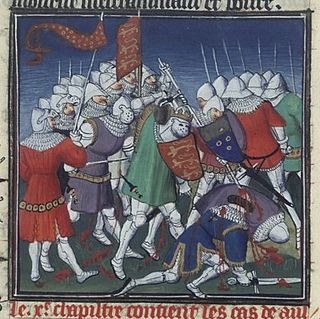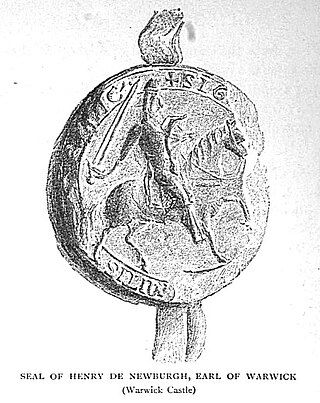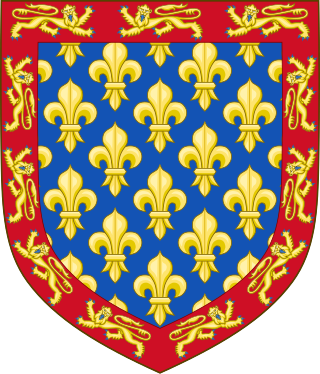
The Battle of Tinchebray took place on 28 September 1106, in Tinchebray, Normandy, between an invading force led by King Henry I of England, and the Norman army of his elder brother Robert Curthose, the Duke of Normandy. Henry's knights won a decisive victory: they captured Robert, and Henry imprisoned him in England and then in Wales until Robert's death in 1134.

Henry de Beaumont, 1st Earl of Warwick or Henry de Newburgh was a Norman nobleman who rose to great prominence in the Kingdom of England.
Robert de Bellême, seigneur de Bellême, seigneur de Montgomery, viscount of the Hiémois, 3rd Earl of Shrewsbury and Count of Ponthieu, was an Anglo-Norman nobleman, and one of the most prominent figures in the competition for the succession to England and Normandy between the sons of William the Conqueror. He was a member of the powerful House of Bellême.

Hamelin de Warenne, Earl of Surrey, was an Anglo-Angevin nobleman, being an elder half-brother of the first Plantagenet English monarch King Henry II.

Earl of Surrey is a title in the Peerage of England that has been created five times. It was first created for William de Warenne, a close companion of William the Conqueror. It is currently held as a subsidiary title by the Dukes of Norfolk.
William de Warenne, 1st Earl of Surrey, Lord of Lewes, Seigneur de Varennes, was a Norman nobleman created Earl of Surrey under William II Rufus. He is among the few known from documents to have fought under William the Conqueror at the Battle of Hastings in 1066. At the time of the Domesday Book in 1086, he held extensive lands in 13 counties, including the Rape of Lewes, a tract now divided between the ceremonial counties of East Sussex and West Sussex.
William de Warenne, 3rd Earl of Surrey was an Anglo-Norman nobleman, member of the House of Warenne, who fought in England during the Anarchy and generally remained loyal to King Stephen. He participated in, and ultimately perished during, the Second Crusade.

William III of Ponthieu also called William Talvas. He was seigneur de Montgomery in Normandy and Count of Ponthieu.
Gundred or Gundreda was the Flemish-born wife of an early Norman baron, William de Warenne, 1st Earl of Surrey. She and her husband established Lewes Priory in Sussex.
Richard fitz Gilbert, 1st feudal baron of Clare in Suffolk, was a Norman lord who participated in the Norman conquest of England in 1066, and was styled "de Bienfaite", "de Clare", and of "Tonbridge" from his holdings.
Elizabeth of Vermandois, was a French noblewoman, who by her two marriages was the mother of the 1st Earl of Worcester, the 2nd Earl of Leicester, the 3rd Earl of Surrey, and of Gundred de Warenne, mother of the 4th Earl of Warwick.
William of Mortain was Count of Mortain and the second Earl of Cornwall of 2nd creation.

Helias of Saint Saëns (?–1128), Count of Arques was a Norman magnate of the eleventh and twelfth century, a loyal supporter of Robert Curthose and protector of his son William Clito. His support of the latter eventually brought him into conflict with Henry I of England, ending in his willing exile from Normandy.

Stephen of Aumale was Count of Aumale from before 1089 to 1127, and Lord of Holderness.
Isabel de Warenne, 4th Countess of Surrey was an English peer. She was the only surviving heir of William de Warenne, 3rd Earl of Surrey, and his wife, Adela, the daughter of William III of Ponthieu.
Events from the 1100s in England.
Walter Giffard, Lord of Longueville in Normandy, 1st Earl of Buckingham was an Anglo-Norman magnate.

Gerbod the Fleming, of Oosterzele, 1st Earl of Chester, was a hereditary advocate of the Abbey of Saint Bertin at Saint-Omer, Flanders and Earl of Chester in 1070.
Reginald de Warenne was an Anglo-Norman nobleman and royal official. The third son of an earl, Reginald began his career as an administrator of his brother's estates, and continued to manage them for his brother's successor, William, the second son of King Stephen. Reginald was involved in the process that led to the peaceful ascension of Henry fitzEmpress to the throne of England in 1154 and served the new king as a royal justice afterwards. He played a minor role in the Becket controversy in 1170, as a member of the party that met Becket on his return to England from exile in 1170.

The de Warenne family were a noble family in England that included the first Earls of Surrey, created by William the Conqueror in 1088 for William de Warenne, 1st Earl of Surrey, who was among his companions at the Battle of Hastings. The family originated in Normandy and, as Earls, held land there and throughout England. When the senior male-line ended in the mid-12th century, the descendants of their heiress adopted the Warenne surname and continue as Earls of Surrey for another two centuries. Several junior lines also held land or prominent offices in England and Normandy.








